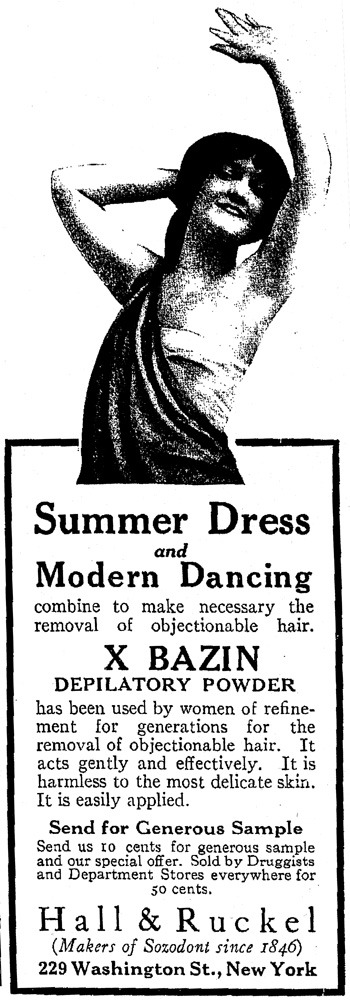
U.S. women were browbeaten into shaving underarm hair by a sustained marketing assault that began in 1915. (Leg hair came later.) The aim of the Great Underarm Campaign was to inform American womanhood of a problem that till then it didn’t know it had, namely unsightly underarm hair.
To be sure, women had been concerned about the appearance of their hair since time immemorial, but (sensibly) only the stuff you could see. Prior to World War I this meant scalp and, for an unlucky few, facial hair. Around 1915, however, sleeveless dresses became popular, opening up a whole new field of female vulnerability for marketers to exploit.
The underarm campaign began in May, 1915, in Harper’s Bazaar, a magazine aimed at the upper crust. The first ad “featured a waist-up photograph of a young woman who appears to be dressed in a slip with a toga-like outfit covering one shoulder. Her arms are arched over her head revealing perfectly clear armpits. The first part of the ad read ‘Summer Dress and Modern Dancing combine to make necessary the removal of objectionable hair.’” [see above image]
Within three months, the once-shocking term “underarm” was being used. A few ads mentioned hygiene as a motive for getting rid of hair, but most appealed strictly to the ancient yearning to be hip. “The Woman of Fashion says the underarm must be as smooth as the face,” read a typical pitch.
The budding obsession with underarm hair drifted down to the proles fairly slowly, roughly matching the widening popularity of sheer and sleeveless dresses. Antiarm hair ads began appearing in middlebrow McCall’s in 1917. Women’s razors and depilatories didn’t show up in the Sears Roebuck catalog until 1922, the same year the company began offering dresses with sheer sleeves. By then the underarm battle was largely won. Advertisers no longer felt compelled to explain the need for their products but could concentrate simply on distinguishing themselves from their competitors.
